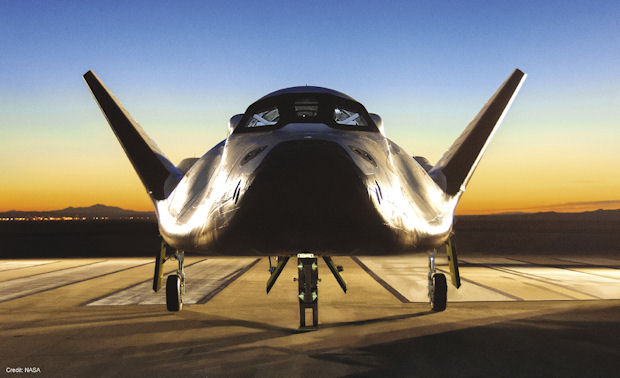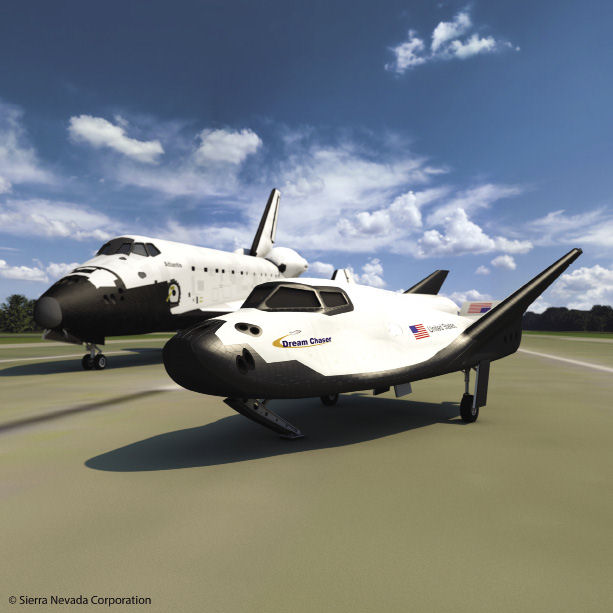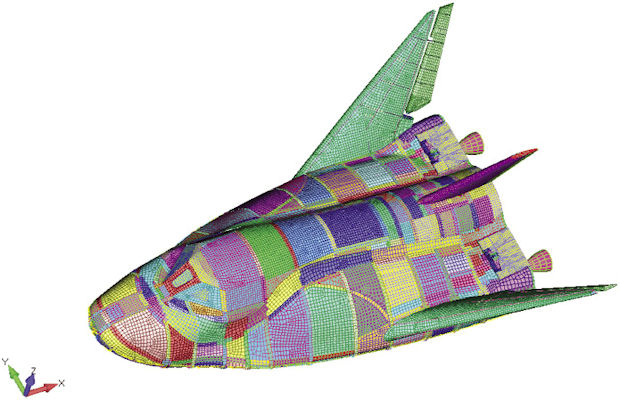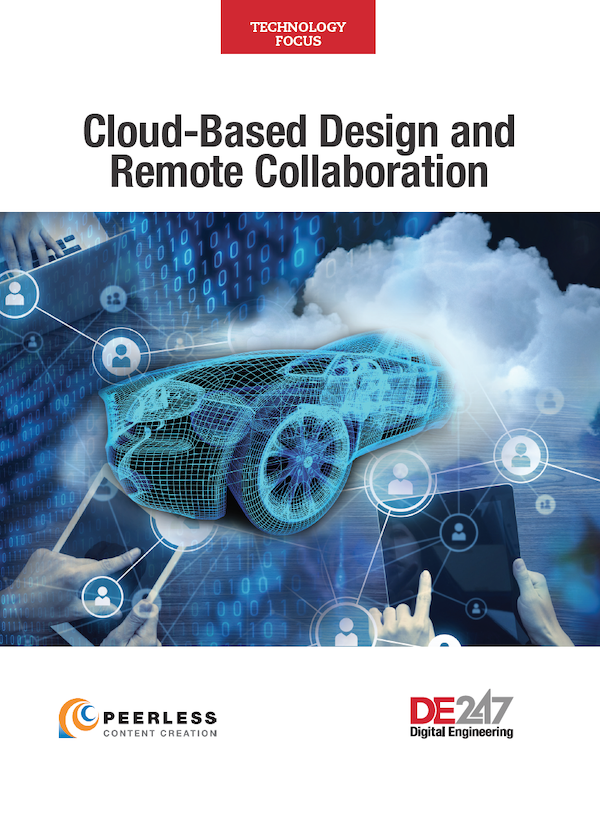Aerospace Engineers Collaborate on the Dream Chaser Spacecraft

Dream Chaser on the runway at NASA’s Dryden Flight Research Center in Edwards, CA. Image courtesy of NASA.
Latest News
December 1, 2014
 Dream Chaser on the runway at NASA’s Dryden Flight Research Center in Edwards, CA. Image courtesy of NASA.
Dream Chaser on the runway at NASA’s Dryden Flight Research Center in Edwards, CA. Image courtesy of NASA.Mankind has been living in space continuously for 14 years. The International Space Station’s (ISS’) first module launched atop a Russian Proton rocket in 1998. Less than a month later, Space Shuttle Endeavor delivered the next module, which began the biggest single construction job in human history—ultimately combining resources from the U.S., Russian, European, Canadian and Japanese space agencies. Now roughly the size of a football field, the ISS has been visited by more than 200 astronauts from 14 countries.
But America hasn’t transported any of those astronauts since the space shuttle was retired more than three years ago. The return of Atlantis from the ISS in 2011 marked the end of 30 years of space shuttle missions. Fifty years after Alan Shepard became the first American and second person to travel to space, all manned space flights to the ISS became dependent on Russian Soyuz spacecraft.
Space Shuttle 2.0
The shuttle’s retirement coincided with the success of NASA’s Commercial Orbital Transportation Services (COTS) program, which incentivizes private companies to develop space vehicles to deliver cargo into low orbit, and the start of the related Commercial Crew Program (CCP) to do the same for manned spaceflight.
The privatization writing was on the wall well before the last shuttle launched. A California company named SpaceDev, known for its work with microsatellites and rocket motors, wanted in on the trend.
“We started thinking, ‘What would you do if you were going to recreate the shuttle?’” recalls Mark Sirangelo, who was chairman and CEO of SpaceDev before it merged with Sierra Nevada Corp. (SNC) in 2008. Sirangelo is now corporate VP of SNC’s Space Systems. “We didn’t have a lot of resources, so we looked for previous vehicles that would fit the bill.”
Sirangelo found what he calls the company’s “space utility vehicle” under a tarp in the corner of a hangar in NASA’s Langley Research Center in Hampton, VA. The HL-20 was a spaceplane concept that would be able to land horizontally on conventional runways. It had initially been developed to augment the space shuttle when NASA planned to have up to 10 crewmembers manning the ISS. The idea was to use it as a rescue vehicle for the crew, but it was scrapped when NASA decided not to man the ISS with that many crewmembers.
The mockup in the hangar was created as part of a cooperative agreement among NASA, North Carolina State University and North Carolina A&T University. It had been used for physical crew testing, ensuring all crewmembers could board and operate the vehicle in their spacesuits. What was most attractive to Sirangelo, however, were the 1,200 wind tunnel tests Rockwell International’s Space Systems Division had performed on the design. All told, the HL-20 hid more than nine years of engineering development under that tarp.
“In the light of a new day and new thinking process, we went in and made two critical decisions,” Sirangelo says. “One: Let’s take a vehicle that already had almost 10 years of work on its outer mold line and a lifting body design that has 20 years of development; and two, let’s mate it with an existing rocket, the Atlas V.”
Those decisions saved significant time and money vs. starting from scratch, but the HL-20 was still just a platform. It had no avionics, life support or propulsion systems, nor did it have any of the software required for command and control, rendezvous or docking. To create what would become the Dream Chaser reusable spacecraft, SNC decided to form a Dream Team.
Balancing Engineering Collaboration and Complication
“We’ve taken the approach on Dream Chaser that we prefer to team up and integrate technology rather than being vertically integrated,” says John Roth, VP of Business Development at SNC’s Space Systems. Roth was formerly president of MicroSat Systems Inc. before it was acquired by SNC in 2008. “Some companies try to develop all the technology themselves. We take the tack that we’re not experts in everything.”
The Dream Chaser Dream Team consists of aerospace industry members, including Lockheed Martin, United Launch Alliance, Draper Laboratory, Aerojet Rocketdyne, MacDonald Dettwiler & Associates Ltd., UTC Aerospace Systems, Jacobs, Moog Broad Reach, Siemens PLM Software, Southwest Research Institute, and many others. SNC is also working with nine U.S. universities and nine NASA Centers and facilities. Finally, the company has established cooperative agreements with the European Space Agency (ESA), the German Aerospace Center (DLR), and the Japanese Aerospace Exploration Agency (JAXA) to explore potential low-Earth orbit missions, following the model of global cooperation set by the ISS.
The Dream Team simplifies the Dream Chaser development by not re-inventing the wheel—or, in this case, the rocket. “We use subsystems and technology that have heritage,” Sirangelo says. “Simplicity comes in a lot of forms. In my world, simplicity is focusing on things that need to be created, not on creating something someone else has already made.”
 The lifting-body design of Sierra Nevada Corp.’s Dream Chaser enables it to potentially land on any commercial runway and draws comparisons with the space shuttle. Image courtesy of SNC.
The lifting-body design of Sierra Nevada Corp.’s Dream Chaser enables it to potentially land on any commercial runway and draws comparisons with the space shuttle. Image courtesy of SNC.Bringing existing technology experts together allows SNC to shorten its development time, and working with other space agencies on their programs enables the company to diversify the Dream Chaser platform. SNC has won more than $337 million in contracts and awards from NASA for crew transportation development, but Boeing and SpaceX were ultimately chosen to continue in the CCP to potentially taxi astronauts to the ISS as early as 2017.
However, variants of the Dream Chaser could be used for cargo missions, grappling and removing space debris, and conducting scientific experiments for NASA, ESA, DLR, JAXA or private companies. Multiple partners and objectives boost the vehicle’s flexibility, but also increase the danger of adding collaboration complications to an already complex engineering workflow.
In addition to the multi-CAD environments represented in the Dream Team, SNC itself is divided into six different business units. Even within the Space System business, which was formed in part by a number of acquisitions, different engineers are accustomed to using different design engineering software.
Bringing all of those engineering teams together exposed some weaknesses in working with large computer-aided design files, Roth says.
“We found out right away that there were some big limitations in some of the CAD packages,” he adds. “Just the size of Dream Chaser CAD models and complexity with life support, avionics, etc., was way more complicated than a satellite system, for instance. That’s how we settled on the NX platform.”
Simulation-led Design
Roth says SNC realized a 20% time savings using Siemens PLM Software’s NX integrated product design, engineering and manufacturing software. “In other products, CAD models took forever to load, save and manipulate,” he says, noting that system crashes were a common occurrence. “It was a big complaint from the engineers.”
John Curry, senior director and co-program manager of SNC’s Dream Chaser program, supports Roth’s viewpoint. Curry is a former Space Shuttle and Space Station Flight Director from NASA. He joined SNC in 2010 to lead Dream Chaser’s integrated systems design, development, test and evaluation efforts.
Curry says simulation-led design is the key to reducing costs while improving safety.
“We want to (send people into space) 10 times more safely at 1/20th of the previous cost,” he says. “Doing rapid prototyping via simulation first is a faster path.”
But that path was being obstructed by the file sizes required.
“Our CFD (computational fluid dynamics) file sizes are 10s of megabytes to 10s of gigabytes in size,” he says. “On the CAD side, the current top assembly takes about 8GB of memory on my machine. When I export it into STEP (Standard for the Exchange of Product model data) files, the top assembly is nearing 2GB of total data. We have over 8,000 parts in our current top assembly.”
SNC uses files in the STEP format to share models with its partners who are using different CAD software. Internally, the company uses NX for CAD and for pre- and post-processing of computer-aided engineering (CAE) files, with Nastran as its solver. Siemens’ Teamcenter is used to manage CAE and design data.
“All the stuff we do in terms of how work proceeds is done in design cycles,” Curry says. “All requirements have to sync at the same time. Efficiency is critical, and we can’t afford to make mistakes.”
Aerospace Design Heritage and Humanity
The recent tragedy that led to the death and injury of Virgin Galactic’s SpaceShipTwo test pilots, underscored by the self-destruction of Orbital Sciences’ Antares rocket just after its October launch, illustrate why mistakes are not an option in spaceflight.
In SNC’s case, there is currently only one Dream Chaser that is being used for testing.
“We pushed a lot of our hardware requirements upfront,” Sirangelo says. “The Space Shuttle Enterprise flew five times, and never went into orbit. We followed that path of building a vehicle for testing.”
Sirangelo says SNC is proud of the Dream Chaser’s space shuttle heritage, but new software technology adds functionality and complexity that shuttle engineers didn’t encounter.
 NX Nastran is used to run numerous analyses on the global FEM. All operational environments and load cases are evaluated to ensure structural strength and stability across the entire platform. Image courtesy of SNC.
NX Nastran is used to run numerous analyses on the global FEM. All operational environments and load cases are evaluated to ensure structural strength and stability across the entire platform. Image courtesy of SNC.“In effect, we are creating something that has never been done,” he says. “The space shuttle has flown 135 times, but it was not a software-driven vehicle. I have more software power in my laptop than the space shuttle had. While the general perception is that we’re a smaller, more efficient version of the space shuttle, the truth is it’s a completely different type of vehicle.”
The Dream Chaser requires fully autonomous flight. SNC, which was responsible for the final minute of the so-called “seven minutes of terror” that allowed the Mars Rover Curiosity to land, is familiar with the demands and complexity of robotic flight.
“It’s not just the software, it’s how the software integrates with all the other things that need to happen,” Sirangelo says. As an example, he calls out Dream Chaser software that could predict the weather so that it can direct hardware to correct for wind gusts—all while traveling at 17,500 mph. That’s a decision humans can’t make fast enough.
But to develop that software as part of a complex system, relationships are key. To ensure all of the Dream Team members finish their design cycle requirements at the same time might require one partner to work overtime or change gears. “It requires more than just technology,” says Sirangelo. “It requires good relationships with partners so they’ll push ahead when needed.”
He says success is dependent upon being able to build relationships where everyone has common view. When used in an efficient workflow, the design engineering technology—from CAD, simulation and visualization software to workstations and prototypes—support that common vision.
“Transparency makes simplicity,” Sirangelo says. “The technology tools we use enable the transparency that allows simulation-led design to begin earlier.”
More Info
Subscribe to our FREE magazine, FREE email newsletters or both!
Latest News
About the Author
Jamie Gooch is the former editorial director of Digital Engineering.
Follow DE




